Kodak Agfa has not finished the Fayoum series. After all who would have thought that one quick-day trip to the Wadi El-Rayan protectorate would yield all those photos.
We stopped last time in Fayoum at its Magic Lake and its surrounding area. Now it is time to visit Fayoum’s crown jewel and its UNESCO World Heritage Site: Wadi El-Hitan.
A quick intro to Wadi El-Hitan: 150 km away from Cairo, Wadi El-Hitan which means in Arabic “Whales valley” is a paleontological site which hosts hundreds of whale fossils and other creatures from millions of years ago. Warning: This post is like a return back to a geology class but it is worth it.
Now Egypt’s Whale Valley is an extremely important paleontologically and historically site because it solves one of the biggest mysteries concerning the evolution of whales.
Unlike what you think, from 50 million years ago Earth’s most giant mammals aka the Whales were actually on-land animals that used to walk on legs before becoming giant gigantic mammals living in oceans.
Between 45-30 million years ago during the Eocene epoch, whales began their transition from on-land animals to Swimming big fishes as the world’s temperature was extremely high in its beginning and then cooled down by its end.
Among all the places, Wadi El-Hitan has the largest collection of whale fossils from that era as well as other animals and fishes in an amazing way considering the fact, we are speaking about a desert now.
If you do not know from millions of years ago the great Sahara including Egypt’s Western desert was part of a huge ocean and due to climate change “evidence for those deniers” we got this dry huge desert reminding us of what can happen again
The first whale fossil was unearthed in Wadi El-Hitan in 1902 and for 80 years there had been no serious excavation due to the difficulty to reach the site. In the 1980s, with the emergence of 4x4 safari trips to the site, more foreign Western Universities began to put an eye on that site.
In 1989, Egypt declared the area of Wadi El-Rayan a natural protectorate. Already Wadi El-Hitan is located inside it so it has been part of a protectorate then.
According to news investigative reports during the time of Mubarak, Egypt’s Western desert especially Fayoum dinosaurs and pre-history creatures haven for years Western Universities like Michigan University.
In 2005, UNESCO announced Wadi El-Hitan as World Heritage Site. It is the first Natural World Heritage site in Egypt. In 2008, it was officially inaugurated as an open museum.
 |
| Egypt's Fossil and Climate Change Museum's open area |
Now the amazing site got two museums: The open-air Museum and the Fossil and Climate Change Museum.
In January 2016, Egypt inaugurated the Fossil and Climate Change Museum inside the Wadi El-Hitan protectorate.
 |
| The Museum's inauguration plate |
The United Nations Development Programme (UNDP) built the Museum in cooperation with the Egyptian government with the financial support of the Italian government as it allocated USD 2.17 billion to fund the Museum.
 |
| The Fayoum UFO |
The Museum Building looks coming out of a Star Wars episode with its dome shape. It is nicknamed in Fayoum the Fayoum UFO.
The Fayoum UFO was designed by architect Gabriel Mikhail of Image House who says that the design was inspired by the nature mirroring the earth’s tone colours, textures and shapes of the surrounding landscape.
You must check Mikhail’s YouTube Channel for very interesting content from Egypt’s deserts.
Personally, I believe it is an innovative design that goes with the surrounding environment perfectly and amazingly it is much bigger than you think.
 |
| The buildings inside the Fossil and Climate Change Museum |
Mikhail also designed the tourist centre and other buildings on the site.
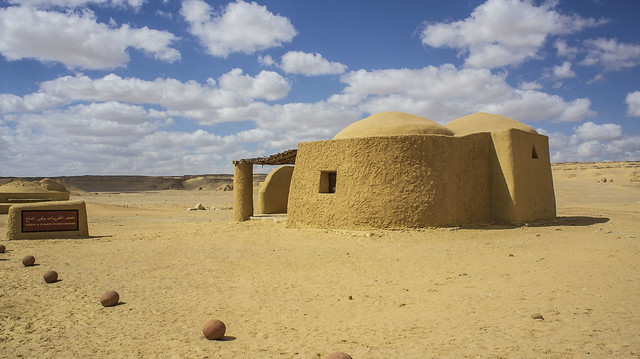 |
| A building inside Egypt's Fossil and Climate Change Museum |
Again, I have not added any clouds to the photos.
Let’s go inside, to see one of Egypt’s true Jurassic park museums.
I remember before heading to the main hall showing the fossils and remains of what walked on that earth millions of years ago, we headed to a hall where we watched a documentary produced by the UNDP in cooperation with the BBC about the history of the region.
It is narrated in Arabic but got English subtitles as far as I remember.
Now to our fossils in a land that witnessed thousands and thousands of whales walking on it before becoming earth’s biggest swimming mammals.
The centrepiece of the museum and its jewel is a 37-million-year-old “Basilosaurus Isis” whale fossil.
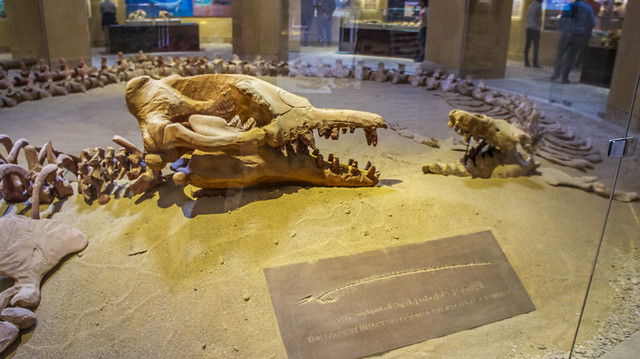 |
| The Basilosaurus Isis skeletons |
According to the Museum, this was the largest intact 18-meter skeleton discovered in the world from the Basilosaurus family. It was discovered in 2005 by a team from the University of Michigan and Egyptian researchers.
Basilosaurus means “King lizard”.
Since the 19th century, hundreds of fossils of those legged form whales were found in Fayoum’s Wadi El-Hitan including this skeleton that was first shown to the world in January 2016 during the inauguration of the museum.
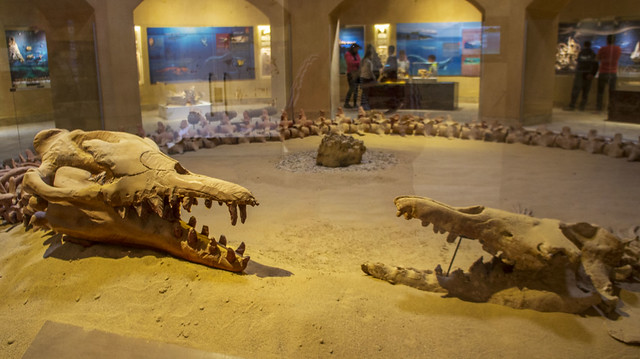 |
| The Basilosaurus Isis skeletons |
There are two whale skeletons, the longest is the star of the museum.
When Basilosaurus was first discovered, scientists thought that Basilosaurus was actually a sea-going reptile but later they found out that it is the whales’ great grand ancestor thanks to that discovery in Fayoum’s own valley of the whale.
Those huge mammals once walked in Fayoum and due to climate change and adaption cycles, they became swimming whales or earth's biggest creatures.
 |
| The Basilosaurus Isis skeletons |
The Basilosaurus had limbs including arms and this is how the arms look according to this fossil cast found in Fayoum.
According to what I understood our native Basilosaurus Isis was like a missing transitional link for scientists as it presented a look into how whales eventually lost their back legs and arms turning into big swimming mammals.
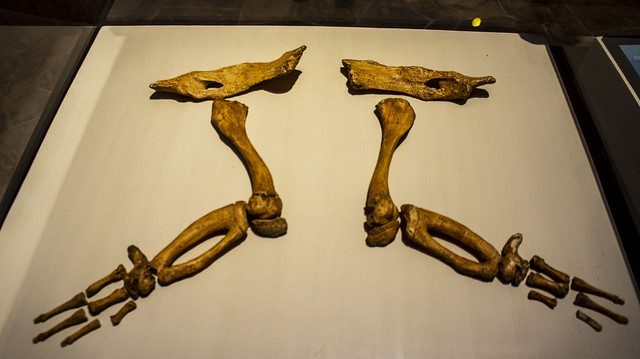 |
| Basilosaurus Isis' arms fossil cast |
That fossil cast is from the Upper Eocene age.
If you think that the Basilosaurus Isis was smaller than its descendent, think again because it may look smaller but here is a part from its lower jaw.
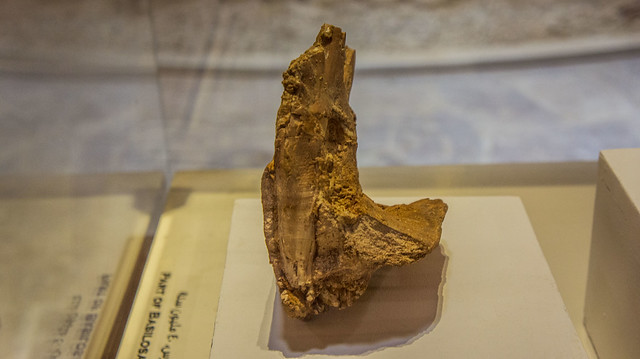 |
| The partial lower jaw of Basilosaurus |
This part of the lower jaw is 40 million years old.
I do not know much but I assume Basilosaurus Isis got its Isis name in tribute to the Egyptian ancient deity Isis.
Already reading about the history of the area, I know that one of the species found in Wadi El-Hitan was named Osiris.
Basilosaurus Isis is not the only whale in the museum, there are other types and kinds like the Dorudon Atrox whale.
Dorudon evolved from the Basilosaurus family aka Basilosauridae.
Here is a complete Dorudon whale, which I do not imagine how it ended to be like that !!
 |
| A Dorudon whale's complete skeleton |
It seemed that it was crushed somehow and became like that maybe!!
I think that this is the skull of that very ancient creature.
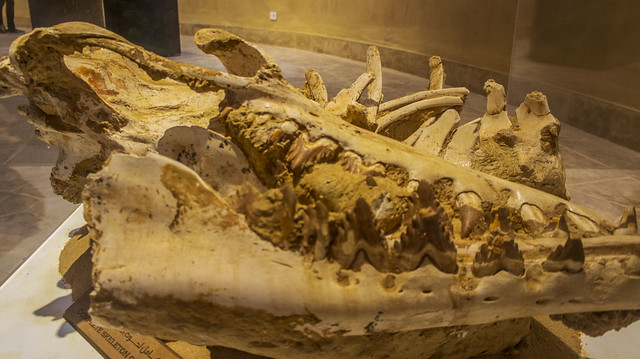 |
| The Dorudon's skull |
It used to have sharp teeth.
Here is the sternum of Dorudon Atrox from the Eocene age.
 |
| The sternum of Dorudon Atrox from the Eocene era |
That’s thick bone for sure.
Now the Dorudon evolved into whales and another familiar swimming mammal: Friendly dolphins
Here is the skull of a modern-day bottlenose dolphin that is considered a descendant of Dorudon.
 |
| A skull of modern-day bottlenose dolphin |
Yes, the most popular dolphin is the great-grandson of Dorudon.
Besides the Fayoum’s Basilosauridae, we also got the family of Remingtonocetidae whales.
Here are the pelvis and femur bones of Remingotoncetid or to be specific a Rayantistes whale from the Eocene age that was discovered in Fayoum near the Jabal Al-Madawara in Wadi El-Rayan protectorate shortly before the inauguration of the Museum.
 |
| The pelvis and femur bones of Remingotoncetid |
The Reminigtoncedtidae are primitive Eocene cetaceans that represented a unique example of cetacean evolution according to the Museum's information.
The Cetacea is like a big umbrella under which lays the aquatic mammals aka dolphins and whales.
Remingtonocetidea were believed to exist in India and Pakistan till those bones were discovered in Egypt’s Fayoum.
Here is also a lower jaw of a Protocetid whale from the Eocene age.
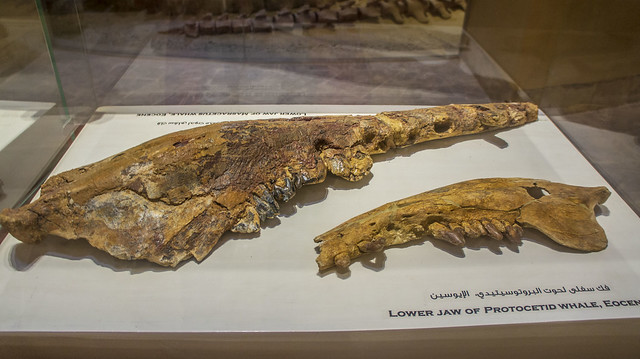 |
| The lower jaw of a Protocetid whale |
That’s a big jaw.
Because Fayoum was part of the famous Tethys ocean we got other aquatic creatures that lurked in the desert for many millennia like sharks and rays.
Here are fossils of sharks’ teeth, fish vertebrates and saw fish’s teeth.
 |
Fossils of sharks’ teeth, fish vertebrates and saw fish’s teeth. |
The fossils of sharks and rays are actually abundant in at the Whales valley that they are exposed on the surface according to the Museum’s info.
They are being identified by their teeth and according to taxonomic evaluation shows that these fossils actually belong to 90 species !! Imagine the number !! 90 species !!
Here is a fossil of crab.
 |
| Fossilized crab |
It is amazing that it looks similar to its decedents after all those millions of years.
Here are fossils of fishes that go back to 35 million years ago.
 |
| Upper Eocene fossilized fish |
I am sorry that the photo is a bit shaky but I could not ignore it.
There is also that fossil of a marine turtle.
 |
| An internal mold of a marine turtle |
We will stop here for now and conclude our the first part of our trip to Egypt’s Fossil and Climate Change in Egypt Museum.
It is not over yet.
Stay tuned for the second part.
All photos were taken by Sony Nex 5 with an E18-55 mm lens.

No comments:
Post a Comment
Thank You for your comment
Please keep it civilized here, racist and hateful comments are not accepted
The Comments in this blog with exclusion of the blog's owner does not represent the views of the blog's owner.